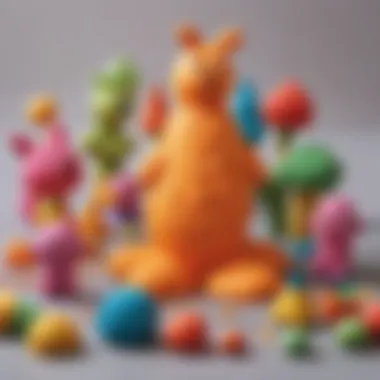Engaging Simple Art Projects for Preschoolers


Intro
Engaging preschoolers in art projects serves not only as a means of self-expression but also enhances their cognitive and motor skills. These activities provide an opportunity for children to explore their creativity while developing essential skills that will benefit them as they grow. The projects discussed here are simple, require minimal materials, and can be replicated easily by both educators and parents.
Creative Activities
Craft Ideas
Craft projects should be fun and simple. Here are a few ideas:
- Paper Plate Animals: Use paper plates to create various animals. Children can draw, cut, and glue on features using colorful paper and natural materials like leaves or twigs.
- Finger Painting: With non-toxic paints, children can use their fingers to create art. This not only stimulates creativity but also enhances fine motor skills.
- Nature Collage: Gather leaves, flowers, and small twigs to make a collage. This connects children with nature while promoting their artistic skills.
Step-by-Step Guides
Providing clear instructions is key for preschoolers. Consider the following example for finger painting:
- Gather Materials: You need non-toxic paints, paper, and a smock or old shirt.
- Set Up: Cover the table with newspapers. This offers protection and ease of clean-up.
- Start Painting: Encourage children to dip their fingers in different colors and make patterns or images.
- Drying: Allow the artwork to dry flat on a clean surface.
Educational Value
Art projects offer numerous educational benefits:
- Fine Motor Skills Development: Activities like cutting, gluing, and painting enhance dexterity.
- Creativity and Imagination: Open-ended projects allow for free expression.
- Cognitive Skills: Planning a project requires decision-making, promoting problem-solving skills.
Engaging children in creative activities nurtures their development, making it a crucial part of early education.
Creating a routine of art projects can help preschoolers express themselves, develop their skills, and enjoy learning through play. The benefits extend beyond immediate enjoyment; they lay the foundation for future learning and creativity.
Prolusion to Simple Art Projects
Art holds a significant place in the lives of preschoolers. Simple art projects serve as an effective method to engage young children, allowing them to explore their creativity while also supporting their developmental needs. These activities can be performed with common materials, making them accessible to families and educators alike. Through art, children can express themselves and let their imaginations flourish. This article delves into the essential aspects of art projects tailored for preschool-aged kids, showcasing their benefits and practical execution.
Understanding the Importance of Art
Art is not merely a pastime for young children; it is a vital part of their overall growth. Engaging in art encourages preschoolers to form connections with the world around them. Here are some essential points about the importance of art:
- Self-Expression: Kids can express their feelings and thoughts visually, which they might struggle to articulate verbally.
- Cognitive Development: Art stimulates brain development. It promotes critical thinking and problem-solving skills, as children learn to make decisions about their creations.
- Cultural Awareness: Through various art forms, kids can learn about different cultures and appreciate diversity in perspectives.
Overall, participating in simple art projects allows preschoolers to freely explore their creativity, which ultimately supports their social and intellectual growth.
Art as a Tool for Development
Art functions as a multifaceted tool in the development of preschoolers. Engaging in creative activities enhances several key areas:
- Motor Skills: Through cutting, gluing, and coloring, small muscles in the hands and fingers develop, improving fine motor skills. This foundational skill is necessary for future tasks, such as writing or buttoning clothes.
- Emotional Development: Art can serve as an outlet for emotions. When children create, they can express feelings such as joy, frustration, or sadness. This emotional exploration is crucial for establishing a sense of self.
- Social Skills: Many art projects can be done in groups, helping children learn to cooperate and share. Working together on a project encourages teamwork and patience among peers.
In sum, simple art projects play a critical role in preschoolers’ development. They foster essential skills through engaging and enjoyable experiences.
Benefits of Simple Art Projects
Art projects offer numerous advantages for preschoolers, serving as a vital component of their overall development. These benefits extend beyond just the immediate enjoyment of creating. Engaging in simple art activities can shape children's cognitive, physical, and emotional skills in profound ways. Through art, children explore their own identities, express thoughts and feelings, and develop essential life skills. The following sections will delve into specific benefits that underscore the importance of these art projects for young learners.
Encouraging Creativity
Creativity is not just about making art; it is a fundamental way for children to express themselves and explore the world around them. Engaging in simple art projects allows preschoolers to experiment with colors, shapes, and materials, fostering original thought and innovation. They can manipulate various supplies, whether it's crayon, paint, or glue, to bring their ideas to life. This encourages not only creative expression but also the problem-solving skills necessary to navigate challenges in art and elsewhere in life.
Through creative processes, children can develop a sense of ownership over their work. This boosts their confidence and motivates them to further engage with artistic endeavors. They learn that there are no strict rules in art, allowing for personal interpretation and exploration. This freedom of expression is critical in nurturing a creative mindset that can be beneficial in academic and social contexts.
Enhancing Motor Skills
Art projects are excellent for developing fine motor skills, which are essential for various daily tasks like writing, fastening clothes, and using utensils. When preschoolers cut, glue, or draw, they practice their hand-eye coordination and dexterity. Simple tasks such as making collages or painting require precise movements which help in strengthening their small muscles.


These activities are not only beneficial for motor development; they also promote focus and concentration. Preschoolers must learn to control their movements and pay attention to the details, enhancing their ability to engage in various activities that require precision. Every stroke, cut, or shape they create contributes to building their physical capabilities and cognitive skills, which will serve them well in their academic journey.
Promoting Emotional Expression
Art serves as a powerful medium for children to express emotions and experiences. For preschoolers, it often is difficult to articulate feelings verbally. Through art, they can communicate complex emotions in a safe and productive way. A child who may feel anxious, excited, or even overwhelmed can channel these feelings into their artwork.
Creating art can also have therapeutic benefits. It provides an opportunity for children to calm their minds and focus on the process of creation instead of any turbulent feelings. When they create, children may recall memories and express stories that matter to them, fostering a sense of security and comfort. This mode of expression can aid in emotional intelligence, helping them to identify their own feelings and understand those of others as well.
Blockquote:
Choosing the Right Materials
Choosing the right materials is essential for engaging preschoolers in art projects. The type of materials used can greatly influence the creativity, enjoyment, and overall learning experience for young children. When considered carefully, materials can enhance fine motor skills and encourage imaginative expression. Accessibility is another critical factor. Parents and educators should aim for materials that are easy to obtain and safe for young children to handle.
The importance of selecting the right materials goes beyond mere convenience. When children are provided with appropriate supplies, they feel empowered to explore their creativity. This often leads to greater enthusiasm and a deeper investment in their work. Moreover, the choice of materials can offer various sensory experiences, adding another layer to their artistic exploration.
Essential Art Supplies
Selecting essential art supplies is key to fostering creativity in preschoolers. These supplies need to be safe, non-toxic, and suitable for young hands. Here is a list of basic supplies that are helpful in any preschool art project:
- Crayons: Ideal for young children, they are easy to grip and come in various colors.
- Watercolor Paints: These facilitate colors mixing and are easy to clean up after use.
- Finger Paints: Encourages tactile exploration, allowing children to use their hands in the painting process.
- Construction Paper: Available in a variety of colors, it is excellent for cutting and collaging.
- Glue: A simple liquid glue or glue sticks can help attach all sorts of materials together.
- Safety Scissors: These are designed for small hands, making cutting enjoyable and safe.
Each of these supplies can be used in multiple projects, making them versatile choices. They do not only support creative development but also allow for easy integration into different art activities.
Creative Use of Recycled Materials
Using recycled materials not only promotes creativity but also instills a sense of environmental awareness in children. Collecting items like cardboard boxes, plastic bottles, and old magazines can lead to imaginative projects that are resourceful and fun. Here are a few ideas for incorporating recycled items:
- Cardboard Shapes: Cut pieces from cardboard boxes to make structures, shapes, or even collages.
- Bottle Caps: These can serve as game pieces, building blocks, or vibrant painting tools.
- Old Magazines: Kids can cut out pictures or use pages for collage work.
Encouraging children to think outside the box can lead to fascinating results. For instance, a cardboard box could be transformed into a robot, a house, or even a vehicle. Using recycled materials not only keeps costs low, but it also stimulates problem-solving skills as children learn to reimagine the purpose of everyday items.
By integrating recycled materials into art projects, we cultivate creativity while promoting sustainability.
Simple Art Project Ideas
Collage Creations
Collages are a versatile medium for artistic expression. In a collage, children can use various materials like paper, fabric, and even natural items to create a unique masterpiece. This project encourages creativity, as kids decide what to include in their collage. It also helps develop fine motor skills through cutting, gluing, and arranging items.
To guide this activity:
- Gather materials such as magazine cutouts, colored paper, and scissors.
- Use a strong glue stick for easy application.
- Allow kids to freely arrange and compose their collage.
Creating collages promotes creative thinking and allows preschoolers to narrate a story through their art.
Nature Prints
Nature prints are a wonderful way to connect children with the outdoors. This project involves using leaves, flowers, or even rocks to create prints on paper. By discovering textures and shapes found outside, children develop their observational skills. The process involves placing a natural item on paper, applying paint, and pressing down to make a print.
Here are some steps:
- Collect different natural items while on a walk.
- Use non-toxic paint and a roller or sponge for application.
- Encourage children to experiment with various colors.
The experience of seeing the result evokes interest and gives children a sense of ownership.
Handprint Art
Handprint art is a timeless project that provides a personal touch. Children can use their hands to create various designs, from animals to flowers. This project develops fine motor control while being an effective way to document growth over the years.
To create handprint art:
- Choose non-toxic paint suitable for children's skin.
- Help kids paint their hands and press them on paper.
- Let them add details using brushes or markers.


Handprint art allows children to leave their mark, both literally and figuratively.
Paper Plate Masks
Making masks from paper plates is an engaging way for children to explore role-playing and creativity. These masks can represent animals, characters, or even their own faces. The process fosters creativity and helps children express their imagination.
To craft a mask:
- Cut eye holes in a paper plate.
- Use paints, markers, or other materials to decorate.
- Attach a string or stick for easy wear.
Masks can lead to engaging imaginative play, enhancing social skills.
Salt Dough Sculptures
Salt dough is easy to make and fun to mold. This project allows preschoolers to create 3D sculptures, using their hands to shape the clay. Salt dough teaches patience and the importance of following instructions, as they must wait for the sculptures to dry.
Follow this simple recipe:
- Combine one cup of flour, one cup of salt, and half a cup of water.
- Knead until smooth, then shape into desired forms.
- Allow to air dry, or bake at a low temperature.
Salt dough sculptures provide a lasting keepsake of creativity.
Simple Painting Techniques
Painting is a primary medium for artistic expression. Various techniques can be introduced, such as finger painting, sponge painting, or using brushes. Each method offers a different sensory experience and encourages exploration of colors and patterns.
When organizing a painting session:
- Prepare a variety of tools like brushes, sponges, and even household items.
- Use non-toxic washable paints for easy cleanup.
- Allow freedom to explore different painting methods.
Through painting, children express their ideas, develop color recognition, and strengthen hand coordination.
Seasonal Art Projects
Seasonal art projects relate creativity to the rhythms of nature throughout the year. This encourages children to notice changes around them. Projects could include making snowflakes in winter or flowers in spring.
Consider seasonal themes:
- Winter: Create snowflakes from paper.
- Spring: Craft flower baskets using colored paper.
- Autumn: Collect leaves for vibrant collages.
Such art projects connect children with their environment and encourage appreciation for nature.
In summary, these simple art project ideas provide preschoolers with vibrant opportunities for creative exploration. They nurture essential skills while allowing children to express themselves uniquely.
Integrating Learning with Art
Integrating art projects with other learning areas can be a valuable strategy for preschoolers. This approach allows children to explore concepts while engaging in hands-on activities. Moreover, it can greatly enhance retention of information and make learning more enjoyable. Art serves as a bridge between various subjects, allowing children to express understanding creatively. This combination reinforces knowledge in a meaningful way, encouraging both cognitive and emotional development.
Art Projects Linked to Themes
When children participate in themed art projects, they do more than just create; they connect with a broader context. These projects can be aligned with various themes, such as seasons, animals, or community helpers. For instance, if the theme is autumn, a simple project could involve creating leaf rubbings using crayons and paper. Such activities allow children to learn about the changing seasons while developing motor skills.
Here are some potential themes and related art activities:
- Animals: Use stamps or stickers of animals to create a vibrant animal collage.
- Under the Sea: Make ocean scenes with blue paper and paper cutouts of fish and seaweed.
- Community Helpers: Encourage children to draw or paint portraits of community helpers like firefighters or teachers.
These integrated projects can enrich preschoolers’ vocabulary, improve comprehension, and foster curiousity about the world around them.
Using Art to Enhance Early Literacy
The integration of art with literacy promotes early reading and writing skills. As children engage in artistic activities, they can be encouraged to verbalize their thoughts and narrate stories about their creations. This enhances their understanding of language and storytelling.
For example, after making a puppet from a paper bag, children can act out a story with their puppets. This not only brings the characters to life but also fosters dialogue and comprehension.


Additionally, parents and educators can:
- Encourage storytelling during art time.
- Use familiar books as inspiration for art projects, like making crafts related to a favorite story or character.
- Provide opportunities for children to write captions or label their artwork, further bridging the gap between art and literacy.
By weaving art into literacy activities, preschools will aid in developing confident communicators. These skills are foundational, paving the way for successful future learning experiences.
Creating a Supportive Environment
Creating an encouraging atmosphere for preschool art projects is essential. When children feel safe and supported, their creativity flourishes. A nurturing environment cultivates not just artistic skills, but also confidence. It provides them the freedom to explore and express themselves. This section will discuss key aspects of setting up such an environment.
Setting Up an Art Space
A dedicated art space is crucial for fostering creativity. It should be organized yet flexible. Here are some important components to consider:
- Location: Choose a space that is free from many distractions but can still be vibrant. Natural light is a plus, as it energizes the space.
- Materials: Keep various supplies within easy reach. Include items like crayons, markers, paper, glue, and scissors. Avoid clutter; an orderly space helps with focus.
- Safety: Ensure the area is safe. Remove any potentially hazardous items. Supervise young children to prevent any accidents.
- Inspiration: Display completed artworks. This can inspire children to create and feel proud of their work.
A well-organized art space will not only enhance creativity but also ease the setup for any art project.
Encouraging Independence
Fostering independence is vital in art projects. When preschoolers learn to make choices and execute their ideas, they develop vital skills. Here are some strategies:
- Choice of Materials: Allow children to choose their own supplies. This empowers them and promotes decision-making.
- Project Selection: Let them decide which project to undertake. This personal choice increases engagement.
- Provide Guidance, Not Direction: Offer assistance while encouraging them to do things on their own. Asking questions can spark thought without taking control.
- Celebrate Mistakes: Reinforce that mistakes are part of the learning process. This helps them feel secure to try new things and take risks.
By encouraging independence, children learn to trust their instincts. This deepens their engagement with art and enhances their self-esteem.
Creating an environment where preschoolers can explore freely is crucial for unleashing their innate creativity.
Incorporating Technology in Art
In the modern age, technology has permeated nearly every aspect of life, including artistic expression. For preschoolers, integrating technology into art projects opens up a wealth of opportunities. It provides a unique way to engage young children while allowing them to explore creativity in diverse ways. This section outlines how technology enhances traditional art practices and the benefits that come with it.
Digital Art Applications
Digital art applications have made it possible for preschoolers to experiment with colors, shapes, and designs in a user-friendly environment. Many applications cater specifically to young users with intuitive interfaces and fun features. This medium helps children develop their creativity without the mess that traditional art supplies might bring. Some notable digital art applications suitable for preschoolers include:
- Tux Paint: This free program offers a canvas and a variety of tools, making it great for little ones. They can draw, write, and add stickers to their work easily.
- Artie 3000: A coding robot that teaches children to create art through programming. It encourages logical thinking while making art interactive and engaging.
- Procreate: A more advanced app that, while aimed at slightly older users, has features that can captivate preschoolers under adult supervision. It offers a broad range of brushes and customization.
Using these tools, children can learn about colors and shapes in a structured yet enjoyable way. Parents and educators can guide them to explore fundamental artistic concepts through exposure to digital creations.
Using Online Tutorials
Online tutorials have become a valuable resource for both caregivers and young artists. They offer step-by-step instructions on various art projects, making it easier for preschoolers to follow along. Here are some practical ideas about using online tutorials effectively:
- Look for channels that specialize in children's art. These often align projects with preschool curriculum goals.
- Choose age-appropriate tutorials. This ensures that the projects are neither too challenging nor too simple.
- Incorporate a variety of mediums. Mixing traditional and digital techniques allows children to broaden their artistic skills.
- Consider guided classes available through platforms like YouTube or educational sites that focus on creativity.
Online tutorials provide an accessible gateway to artistic exploration, allowing children to engage with art in a way that resonates with them.
Incorporating technology in art not only fosters creativity but also prepares children for future learning experiences. By utilizing digital applications and online resources, caregivers can offer preschoolers a more enriched artistic education.
Finale
The conclusion of this article emphasizes the significant role of art in the lives of preschoolers. Engaging children in simple art projects is not just a leisurely activity; it lays a vital foundation for their overall development. The projects discussed throughout this piece offer various benefits that contribute to cognitive, emotional, and social growth.
Through creative expression, children explore their thoughts and feelings. They learn to communicate in ways beyond words, making art a powerful tool for emotional expression. As they manipulate materials, children enhance their motor skills, fostering coordination and dexterity essential for future tasks. Furthermore, collaborative art projects encourage teamwork and patience, building social skills crucial for navigating relationships later in life.
Incorporating art into daily routines cultivates a nurturing environment that supports learning and curiosity. Parents and educators play a critical role in providing the necessary space and materials, encouraging children's self-discovery and creativity.
Engaging preschoolers in art not only nurtures creativity but also fortifies essential life skills.
In summary, the simple art projects outlined in this article are far more than craft activities; they are avenues for communication, development, and connection. By continually introducing these simple art projects, caregivers can foster enriching experiences that resonate throughout a child’s early years and beyond.
Reflections on Engagement through Art
Art projects are inherently interactive and engaging, inviting children into a world where they can explore and experiment. The tactile nature of art-making caters to various learning styles, accommodating children’s unique approaches to understanding their environment.
Children learn best when they are engaged. The hands-on activities presented not only capture their attention but also promote sustained interest. When preschoolers engage in art, they become active participants rather than passive observers. This active participation is crucial as it encourages them to think critically and solve problems creatively.
Considerations for caregivers and educators include recognizing each child’s individual expressions and allowing them the freedom to produce their interpretations without judgment. This freedom fosters an authentic engagement that can lead to deeper connections between the child, the artwork, and their personal experiences.







